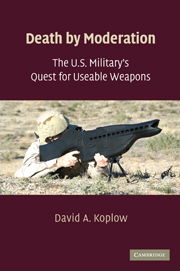Book contents
- Frontmatter
- Contents
- Preface
- Acknowledgments
- Abbreviations and Acronyms
- 1 Revolutionary Weapons and Transformed War
- 2 Deterrence and Self-Deterrence
- 3 The Law of Armed Conflict
- 4 Precision-Guided Munitions
- 5 Low-Yield Nuclear Weapons
- 6 Smart Antipersonnel Land Mines
- 7 Antisatellite Weapons
- 8 Nonlethal Weapons
- 9 What to Do about Useability
- Index
- References
7 - Antisatellite Weapons
Published online by Cambridge University Press: 05 June 2012
- Frontmatter
- Contents
- Preface
- Acknowledgments
- Abbreviations and Acronyms
- 1 Revolutionary Weapons and Transformed War
- 2 Deterrence and Self-Deterrence
- 3 The Law of Armed Conflict
- 4 Precision-Guided Munitions
- 5 Low-Yield Nuclear Weapons
- 6 Smart Antipersonnel Land Mines
- 7 Antisatellite Weapons
- 8 Nonlethal Weapons
- 9 What to Do about Useability
- Index
- References
Summary
Scenario 7
The upcoming war between the United States and Iralia is going to be high-tech. Iralia, a medium-size and more than medium-power country, is even attempting for the first time to exploit outer space for specialized military operations. Although it cannot hope to match the American war fighters in overall satellite technology, Iralia calculates that in three novel applications, turning to the heavens might prove advantageous.
First, although Iralia has no remote sensing satellites of its own, it fully recognizes the value of modern overhead reconnaissance, and it now intends to acquire militarily useful photographic and related data from the satellites of other cooperating countries and foreign private consortia. Some of the contemplated satellite surveillance products are commercially available on the global market; others may be obtainable as concessions from more advanced spacefaring countries that will be officially neutral in the war, but are sympathetic to the Iralian cause.
Iralia figures that these augmented intelligence capabilities may be useful in several ways. As a most obvious example, enhanced meteorology information from space would bolster the ability of the national leadership to know, and to predict, local and regional weather patterns with greater precision and specificity. The Americans, of course, already collect and exploit this kind of information; Iralia hopes to achieve something of a balance in similarly adapting its military operations to the prevailing conditions – and, not incidentally, in being able to forecast better when and where the Americans will decide to undertake their military strikes, too.
- Type
- Chapter
- Information
- Death by ModerationThe U.S. Military's Quest for Useable Weapons, pp. 150 - 187Publisher: Cambridge University PressPrint publication year: 2009



